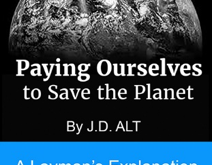RobotBulls: Einsatz von KI und Blockchain zur Datenverarbeitung im Bereich der Kryptowährungen RobotBulls ist ein Technologieentwickler, der sich auf die Anwendung von künstlicher Intelligenz (KI) und Blockchain-Technologie spezialisiert hat. Diese Technologien werden genutzt, um Datenanalysen im Kontext von Kryptowährungen zu unterstützen. Dieser Artikel beschreibt die technischen Merkmale und die Anwendungsbereiche von RobotBulls. Technische Aspekte der Datenanalyse RobotBulls nutzt...
Read More »New Economic Perspectives 1970-01-01 00:00:00
[unable to retrieve full-text content]
Read More »Standard Money Theory and the Coronavirus
By J.D. ALT The theme and illustrations of this essay are from the new book “Paying Ourselves to Save the Planet.” It might seem, as we observe the U.S. government “instantly” generating $2 trillion new dollars for direct payments and grants to people and businesses, that the coronavirus pandemic has shed a new light on the authenticity (and necessity) of modern money theory (MMT). But that light, if it is being shed at all, is illuminating instead the dramatic limitations of the...
Read More »Standard Money Theory and the Coronavirus
By J.D. ALT The theme and illustrations of this essay are from the new book “Paying Ourselves to Save the Planet.” It might seem, as we observe the U.S. government “instantly” generating $2 trillion new dollars for direct payments and grants to people and businesses, that the coronavirus pandemic has shed a new light on the authenticity (and necessity) of modern money theory (MMT). But that light, if it is being shed at all, is illuminating instead the dramatic limitations of the...
Read More »Standard Money Theory and the Coronavirus
By J.D. ALT The theme and illustrations of this essay are from the new book “Paying Ourselves to Save the Planet.” It might seem, as we observe the U.S. government “instantly” generating $2 trillion new dollars for direct payments and grants to people and businesses, that the coronavirus pandemic has shed a new light on the authenticity (and necessity) of modern money theory (MMT). But that light, if it is being shed at all, is illuminating instead the dramatic limitations of the...
Read More »Manhattan Project to prevent Hyper-Inflation
By J.D. ALT It’s ironic that, at this moment, when the truthfulness and utility of modern money theory (MMT) is being publicly realized—(and even potentially implemented!)—that its singular vulnerability must emerge as a real concern: hyper-inflation. The most recent thing I’ve written—Paying Ourselves to Save the Planet—addresses the issue of hyper-inflation as follows: “Hyper-inflation” is a rate of inflation that happens so rapidly there’s no opportunity for people and businesses to...
Read More »Manhattan Project to prevent Hyper-Inflation
By J.D. ALT It’s ironic that, at this moment, when the truthfulness and utility of modern money theory (MMT) is being publicly realized—(and even potentially implemented!)—that its singular vulnerability must emerge as a real concern: hyper-inflation. The most recent thing I’ve written—Paying Ourselves to Save the Planet—addresses the issue of hyper-inflation as follows: “Hyper-inflation” is a rate of inflation that happens so rapidly there’s no opportunity for people and businesses...
Read More »Manhattan Project to prevent Hyper-Inflation
By J.D. ALT It’s ironic that, at this moment, when the truthfulness and utility of modern money theory (MMT) is being publicly realized—(and even potentially implemented!)—that its singular vulnerability must emerge as a real concern: hyper-inflation. The most recent thing I’ve written—Paying Ourselves to Save the Planet—addresses the issue of hyper-inflation as follows: “Hyper-inflation” is a rate of inflation that happens so rapidly there’s no opportunity for people and businesses...
Read More »STANDARD MONEY THEORY
By J.D. ALT The last two and a half months I’ve been at work on a new book. As it evolved, I found I was approaching MMT from a new direction—one which made an explanation of MMT much less counter-intuitive and, perhaps, less controversial. The approach is relatively simple and straight-forward: follow what I began calling “standard money theory” step by step until one reaches a perspective that has, almost seamlessly, become “modern money theory.” The book first considers why the...
Read More »STANDARD MONEY THEORY
By J.D. ALT The last two and a half months I’ve been at work on a new book. As it evolved, I found I was approaching MMT from a new direction—one which made an explanation of MMT much less counter-intuitive and, perhaps, less controversial. The approach is relatively simple and straight-forward: follow what I began calling “standard money theory” step by step until one reaches a perspective that has, almost seamlessly, become “modern money theory.” The book first considers why the...
Read More » New Economic Perspectives
New Economic Perspectives






